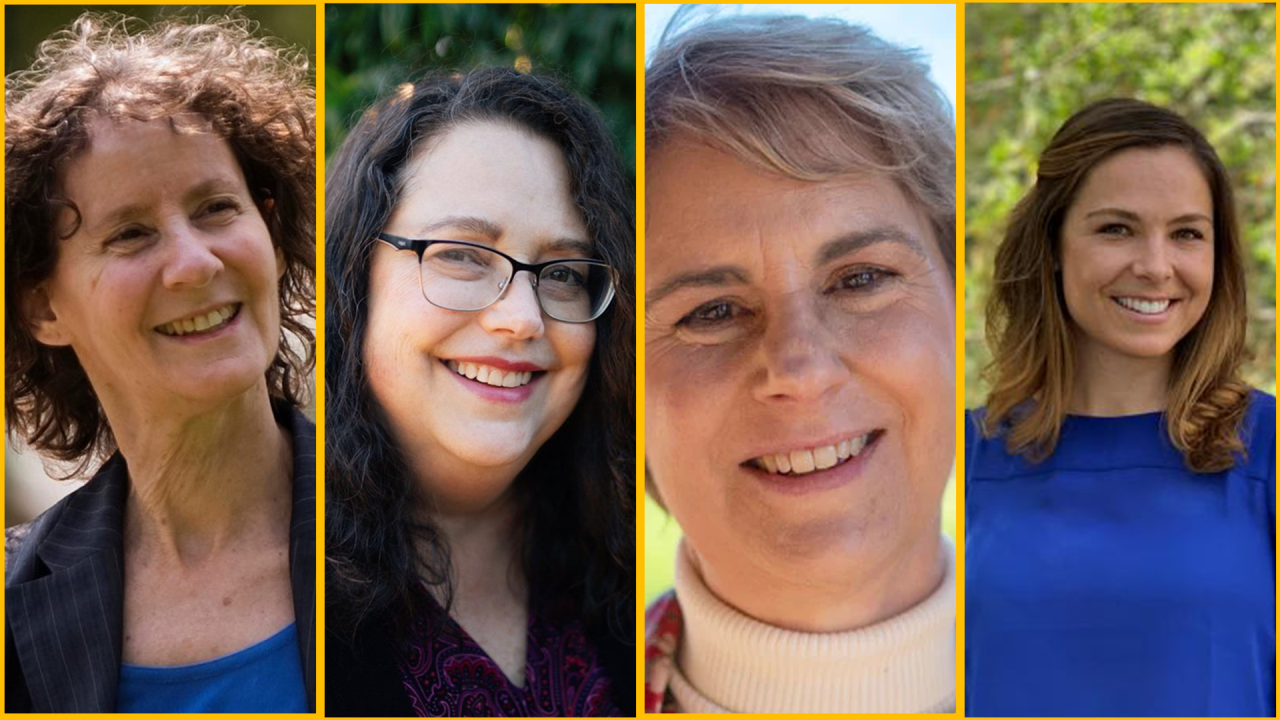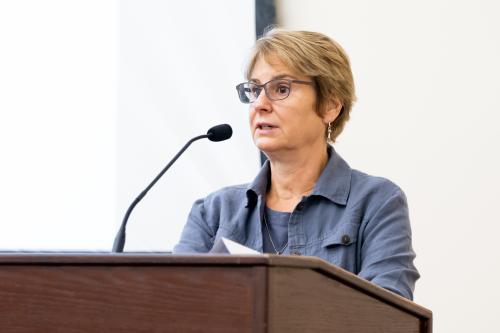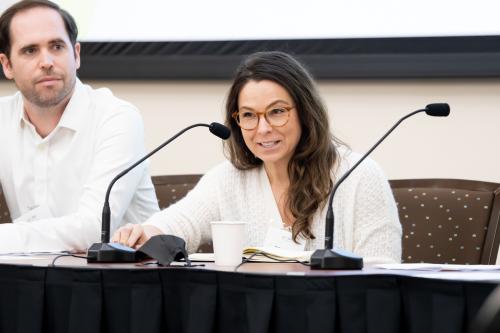
International Women in Science Day Q & A
February 11th: International Women and Girls In Science Day
February 11th is International Women and Girls In Science Day. To celebrate, we sat down with four of the Environmental Health Sciences Center Core Leadership Group to ask them about their experience as women in the STEM field and what advice they would give to the next generation.
Below is an edited transcript of our conversation.
Why do you feel it’s important to see women in STEM?
Irva Hertz-Picciotto, Ph.D. - There are so many reasons. So many women are very talented in scientific, technology, engineering, and mathematical fields. They are eager to put their skills to work but, for centuries, have been excluded from those opportunities. Just this week, I was reminded that a brilliant epidemiologist and statistician, Janet Lane-Claypon, had to leave her job when she got married because that was the law in England then. Who knows how much more she could have accomplished had she been able to retain her position? Moreover, Janet Lane-Claypon came from a wealthy family and was, therefore, able to attend a highly esteemed college. At the same time, other equally brilliant women have been unable to acquire the education that would allow for such contributions.
Another reason is that role models are essential to our education and influence our aspirations. Seeing women who came before you and what they do or have done helps you envision yourself in roles you might not think of if you only saw men in those roles.
Kathryn Conlon, Ph.D. - We know that historically women have been geared away from STEM fields. I think it's important to be role models for women who are interested in STEM. For me, there weren't a lot of female scientists who talked about the balance between family and science life, which I think sometimes gets lost. That's changing now with a younger population of female scientists starting to discuss the balance between life and work. It's important for females, males, and non-identifying individuals to see different types of people in STEM. Diversity of thought is so beneficial to our field.

Pam Lein, Ph.D. - I think seeing women fully and equally engaged in STEM is critical for advancing science. The more diverse opinions and perspectives we can bring to a problem, the more likely we are to find the answers and our way toward the solutions to these complex problems.
We know from neuroscience research that women have a different process for attacking questions and problems. And I think it is a complementary mix of the different approaches that allows you to arrive at a much fuller understanding of the problem. We're going to need this to solve these complex environmental problems that we're facing today.
Laura Van Winkle, Ph.D. - It's hugely important because you can't be what you can't see. Young scientists are more inclined to aspire to a position when they see another person like them in the field. The other reason it's imperative is that we know from scientific studies that diversity of ideas leads to more robust science. And so, to have diverse views, you need ideas from all men, women, people from all walks of life, and people of different sexes, genders, ethnicities, and backgrounds. With this valuable diversity, your research questions and science are much more robust.
Why did you get into the field of work that you are in? What drew you to science?
Laura Van Winkle, Ph.D. - I am in the area of work I'm in because I have family members who have asthma and other lung diseases. I grew up in the L.A. Basin in the early sixties and through the seventies. I can still remember the look, taste, and smell of the air pollution in Los Angeles during that era. It was oily and gross. It exacerbated asthma in my family members. And my family was convinced very, very early on that air pollution was impacting lung health. So, I'm deeply intrigued by how environmental exposures impact the lung.
Kathryn Conlon, Ph.D. - For a long time, I have been very interested in the environment in general and the relationship between the environment and humans. In my undergraduate training, I learned about climate change. And that has been an issue that has driven much of my interest from the get-go. I've been lucky to build my career around climate-related exposures and issues, which I think will guide a lot of my professional progress in the future.
When you were going through your undergrad and your Ph.D. programs, did you notice a lot of women alongside you in your respective STEM fields?

Pam Lein, Ph.D. - There were very few women at the time I was going through school, and there were a couple of very notable, well-known women neurotoxicologists who served as my role models. But there have been very few women in those fields, traditionally. It's changing today, of course, where we see predominantly women entering graduate school. But back in the day, I was kind of an odd duck.
Kathryn Conlon, Ph.D. - In my academic career, the distribution has shifted to many women scientists working in climate and health. So it's been variable. In environmental health? I would say it varied depending on where I was. During my Ph.D. training in environmental health, we had more women than men in my Ph.D. cohort. When I worked at the National Center for Environmental Health at the CDC, I was one of three women classified as a scientist in my particular program.
What advice would you give to the next generation of scientists and researchers?
Kathryn Conlon, Ph.D. - I encourage new scientists to be curious and to stay curious. The sciences are so exciting even though science can be a slow-moving process. Sometimes we get caught up in our projects, and we can lose sight of the real wonder about the things around us. By remaining curious as scientists, we can incorporate a lot more creativity into our work, which also maintains energy and enthusiasm.
I think, especially as it relates to climate, curiosity will be one of the engines that spur innovation and solutions-type thinking. I would like to see science engage more in the climate crisis. When looking at how we can work together, my work is solution-oriented. I try to focus on how we can come up with solutions to the climate crisis and to climate and health problems. And the best way, that I found, is through very truly interdisciplinary work.
Laura Van Winkle, Ph.D. - If, at first, you don't succeed, try again. It took me a while to figure out where I wanted to be in science. I wandered around the biological science space before I ended up where I am now. There are so many areas of STEM, and it's normal to have a process of searching to find out where your passion lies, but also to align it with what you're good at. And so, just be patient with that process and yourself. And if you have passion for something, follow up! And don't be afraid to reach out to established scientists in your field. I love to talk to up-and-coming new researchers, so please do reach out. You'll be surprised that they will respond to you and would love to have a conversation.
Pam Lein, Ph.D. - The one piece of advice I would give is that you need to be resilient. Resiliency is the number one tool I had as an advantage during my training. And even today, resilience is key when I'm trying to get grant funds and communicating with diverse stakeholders about a particular problem or question. Learning the tools of resiliency, embracing resiliency – that is crucial to success. And part of resiliency is making time for yourself to reflect, meditate, exercise, eat well, and to sleep. I see many young people today driving themselves to the brink of exhaustion. And this is not healthy. So this concept of real resiliency, building, and embracing these tools is fundamental.
Thank you to Dr. Irva Hertz-Picciotto, Dr. Pamela Lein, Dr. Laura Van Winkle, and Dr. Kathryn Conlon for their commitment to this project and all of our other female scientists for changing the future of STEM.

Angelina is an EHSC editorial assistant for the communications department and an undergraduate student at UC Davis studying Human Development. She is an aspiring writer with a focus on science communication.

Andrea is the Digital Communications Specialist for the Environmental Health Sciences Center. She manages website content, social media, multimedia content creation and public messaging.